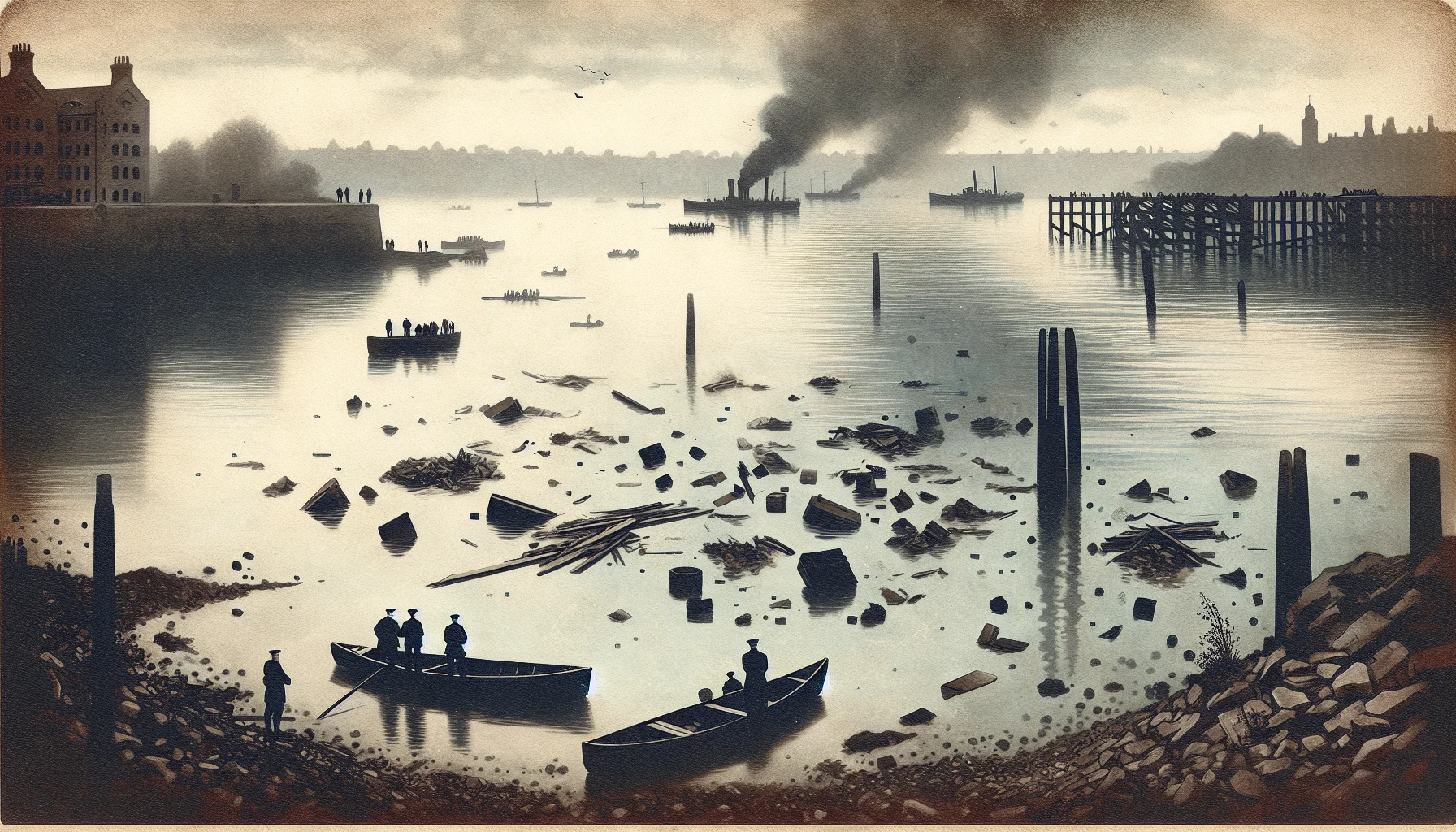
Explosion of HMS Princess Irene
by: The Calamity Calendar Team
May 27, 1915
Into the Calm Before Chaos
In the early hours of May 27, 1915, the Medway Estuary near Sheerness, Kent, hummed with routine naval activity. The morning sun revealed a complex panorama of ships both modest and mighty, their silhouettes disrupted occasionally by the sputter of steam or the whirr of cranes busy at work. Among the docked vessels was the HMS Princess Irene, a ship whose grace had once lent itself to the gentle luxury of transatlantic journeys but was now marooned in the hardened attire of war.
Converted swiftly from a grand liner into a functional minelayer for the British Royal Navy, Princess Irene had traded its opulent decor for racks of deadly naval mines. The ship had become an integral yet underglamorous part of wartime operations, her mission clear: disrupt the shipping lanes of the enemy. This somber routine continued uninterrupted as maintenance and loading proceeded smoothly through the morning mist. But all serenity, as the historical record shows, can change in an instant.
Conversion and Calm
Originally crafted for elegance, Princess Irene had debuted just a year before her conscription into wartime service. World War I's demands were such that the Navy eagerly appropriated civilian vessels, repurposing them for military service. Princess Irene’s transformation was a testament to these desperate times, stripping away her plush furnishings for metallic racks and explosive cargo.
By May 1915, she was a workhorse of the estuary, her civilian life a distant memory. The estuary had become a bustling artery of military logistics and preparation, each vessel there almost humming with the anticipation and tension that was an unspoken part of Naval life during wartime. Yet, as her last routine maintenance wrapped and her fresh cargo of 500 mines was loaded, fate had another story in mind.
A Sudden and Violent Shatter
At 11:14 a.m., an earth-shaking explosion shattered the veneer of tranquility. What stood moments before as the HMS Princess Irene was obliterated in a sound and fury that reached out across the morning air, echoing across Sheerness and rippling through distant towns like Sittingbourne and Gravesend.
Eyewitnesses were frozen in a mixture of shock and incomprehension as debris rained down, parts of the ship and its human cargo flung skywards. In a grim flash, 273 lives were claimed, including crew members and dockyard workers who had moments earlier been simply performing their duties. Tragically, a young boy on a nearby barge became another victim of the cruel force that scattered shrapnel into the estuary breeze, stealing another life much too soon.
Thanks for subscribing!
Picking Up the Pieces
Once the shock subsided, the grim reality of the disaster set in. The waters that had lulled under the weight of ships now carried fragments of dreams and destinies, the detritus of a once-proud liner that never imagined such an end. Recovery and response unfolded amidst a sense of disbelief, with both bodies and charred wreckage pulled from the estuary’s depths over the ensuing days.
As the devastated community and Navy personnel grappled with the scope of the tragedy, questions emerged with the urgency that follows any calamity. Foremost was the query: How could this have happened? Investigators delved into the possibilities—had there been an error in loading? A defect in the mines themselves? Despite meticulous efforts, the mystery, much like the ship, vaporized with few tangible answers—a silent indictment of the explosive age.
Lessons Written in Smoke
While the complete truth of what happened aboard Princess Irene might remain elusive, the explosion did serve to change the landscape of naval operations. Safety protocols regarding munitions were scrutinized, revamped, and introduced with a vigor keen on preventing another occurrence. More stringent training on munitions handling became the watchword, a legacy born out of necessity and sorrow.
The unyielding discipline required for handling these devilish devices, further enshrined by such disasters, informed naval procedures profoundly, an unending reminder of the balance between military might and the ever-present specter of imperfection.
Echoes Across Time
Today, there is muted acknowledgment of the disaster that claimed HMS Princess Irene—a name now resonating more as a cautionary tale than as a mere footnote in naval logs. The event is chronicled with solemnity, a cataloged incident that offers invaluable lessons rather than unearthing definitive conclusions.
Yet, as the calm estuary bears little evidence of the havoc it once revealed, memory’s embers lie smoldering in history’s recess. HMS Princess Irene’s story remains, not just in the archives and ledgers of the past, but in the steadfast procedures that knit safely through the fabric of naval operations—a poignant testament to those who served, and fell, in an era of great uncertainty and change.
Stay in the Loop!
Become a Calamity Insider and get exclusive Calamity Calendar updates delivered straight to your inbox.
Thanks! You're now subscribed.